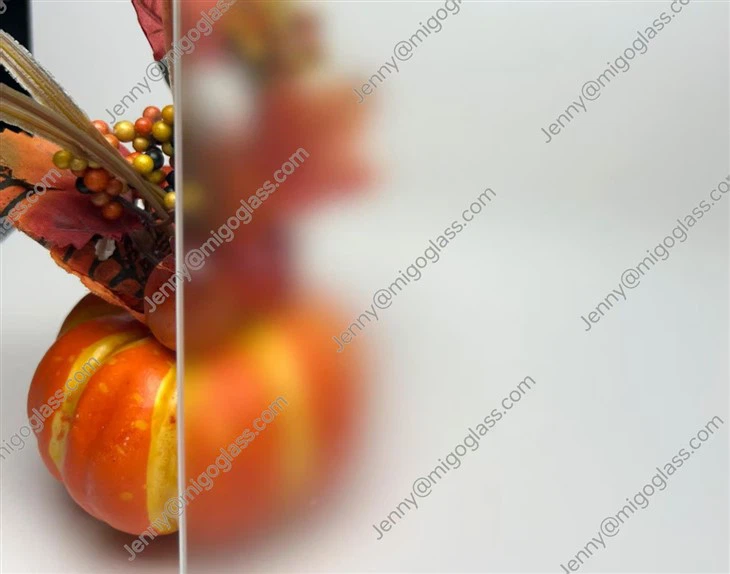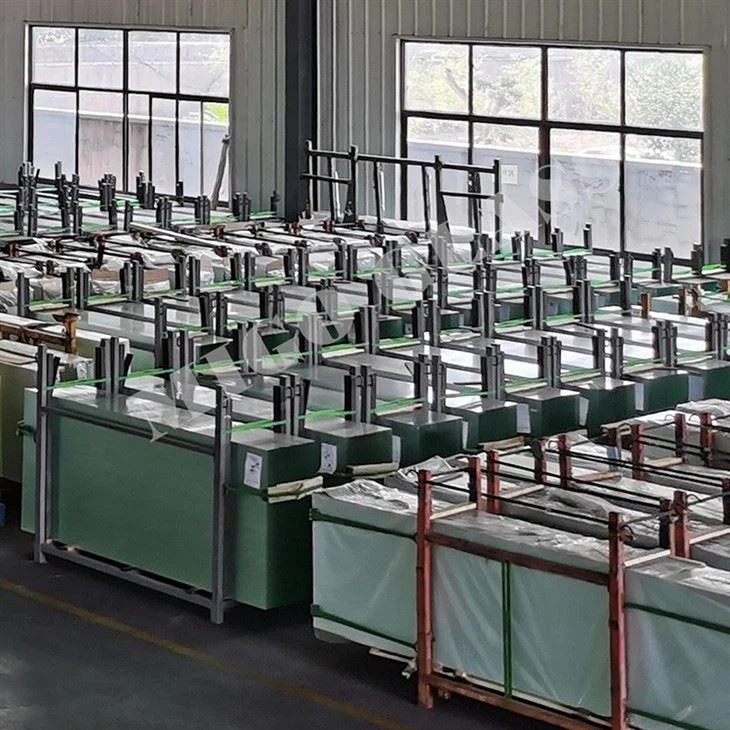How does humidity affect solar collector glass?
May 30, 2025
Leave a message
Humidity is a critical environmental factor that can significantly influence the performance and longevity of solar collector glass. As a provider of high - quality solar collector glass, I understand the importance of comprehending how humidity interacts with this essential component of solar energy systems.


1. Influence of Humidity on Optical Performance
Humidity primarily affects the optical properties of solar collector glass. One of the most immediate impacts is the formation of water droplets on the glass surface. When the air is highly saturated with water vapor (high humidity), and the glass surface temperature drops below the dew point, condensation occurs. These water droplets act as tiny lenses, scattering sunlight in various directions.
The scattering of sunlight disrupts the direct transmission of light through the glass. For solar collectors, which rely on the efficient transmission of sunlight to heat a working fluid or generate electricity, this is a major setback. Freshly deposited water droplets can cause a significant decrease in the amount of light reaching the absorber beneath the glass. The intensity of the scattered light also reduces the overall uniformity of light distribution on the absorber surface, potentially leading to uneven heating.
The degree of optical performance degradation depends on several factors, including the size and density of the water droplets. Smaller and more numerous droplets tend to cause more severe scattering. Moreover, if the humidity remains high over an extended period, the water droplets may combine and form a thin water film on the glass. This film can act like a layer with a different refractive index, further reducing the light transmission efficiency of the glass.
In addition to direct optical effects, humidity can also promote the accumulation of dust and other particulate matter on the glass surface. Water acts as an adhesive, attracting and binding airborne particles to the glass. These particles can reduce the transparency of the glass, blocking sunlight and decreasing the overall energy - collection efficiency of the solar collector. As a reputable supplier, our Low Iron Float Solar Glass is designed to resist such optical performance degradation caused by humidity - related issues. The high - quality materials used in our glass can mitigate the impact of water droplets and particulate adhesion to some extent.
2. Impact on Glass Durability
Beyond optical performance, humidity can have long - term effects on the durability of solar collector glass. Glass is a relatively stable material, but under high - humidity conditions, it can be subject to different forms of corrosion. One of the most prevalent types of corrosion in the presence of moisture is hydrolysis. Water molecules can react with the silicate network of the glass, gradually breaking down and eroding the surface microstructure of the glass.
Hydrolysis is an ongoing process, especially in an environment with elevated humidity and slightly acidic or basic conditions. Over time, this corrosion can cause the surface of the glass to become rough and pitted. A rough surface not only affects the optical properties of the glass but also weakens its mechanical strength. As a result, the glass becomes more vulnerable to mechanical damage, such as cracking from thermal stress or external impacts.
Humidity also plays a role in the expansion and contraction of the glass. Glass, like all materials, has a coefficient of thermal expansion. When there are significant fluctuations in humidity levels, the moisture adsorbed by the glass can cause it to expand and contract. These repeated cycles of expansion and contraction can lead to internal stress within the glass. If the stress exceeds the strength limits of the glass, it can result in micro - cracks and eventually larger fractures.
In coastal areas with high humidity and salt - laden air, the situation is even more severe. Saltwater contains ions that can accelerate the chemical reactions on the glass surface. Chloride ions, for example, can penetrate the glass and react with the metal components in the solar collector system. This can lead to corrosion of the metal frame and seals that hold the glass in place, further compromising the integrity of the entire solar collector unit. To address these durability concerns, our Low - iron Prism - Matt Solar Glass is engineered with enhanced chemical stability and durability. The glass is treated to resist hydrolysis and other forms of humidity - induced corrosion, ensuring a longer service life for the solar collectors.
3. Interaction with Anti - Reflection Coatings
Many modern solar collector glasses are equipped with anti - reflection (AR) coatings to improve light transmission. These coatings are specifically designed to minimize the reflection of sunlight from the glass surface, allowing more light to enter the solar collector. However, humidity can interact with these coatings in complex ways.
High humidity can cause the AR coatings to absorb water. The absorption of water molecules can change the refractive index of the coating, altering its anti - reflection properties. This can lead to an increase in the reflection of sunlight from the glass surface, reducing the amount of light that reaches the absorber. If the humidity is combined with high temperatures, the water absorbed by the coating can cause the coating to swell and even delaminate over time.
The composition and structure of the AR coating play a crucial role in its resistance to humidity. Some AR coatings are more hydrophobic, meaning they repel water better. These types of coatings can reduce the amount of water absorption and the subsequent degradation of AR properties. Our Low Ironn Float Solar Glass With One Side AG Treatment comes with advanced hydrophobic AR coatings. These coatings can effectively resist the negative effects of humidity, maintaining their excellent anti - reflection performance even in high - humidity environments.
4. Impact on Insulation and Thermal Performance
In solar collectors, glass also acts as an insulation layer, helping to trap heat inside the collector. Humidity can disrupt this insulation function. When water vapor condenses inside the solar collector, it can reduce the insulating properties of the air space between the glass and the absorber. Water has a much higher thermal conductivity than air, so the presence of condensed water can cause more heat to be conducted away from the absorber.
This heat loss can have a significant impact on the overall thermal efficiency of the solar collector. Reduced thermal insulation means that more energy is required to maintain the desired temperature of the working fluid, ultimately increasing the operating costs of the solar energy system. Additionally, high humidity can increase the risk of mold and mildew growth inside the solar collector. These organisms not only damage the components but also release heat - absorbing substances that can further disrupt the thermal balance of the system. As a professional solar collector glass supplier, we understand the importance of maintaining good insulation performance. Our products are designed to minimize the risk of condensation and associated thermal performance degradation in high - humidity environments.
5. Mitigation Strategies
To address the challenges posed by humidity, several mitigation strategies can be adopted. For optical performance, regular cleaning of the glass surface is essential. This can remove water - bound particulate matter and prevent the long - term build - up of contaminants. Additionally, hydrophobic coatings can be applied to the glass surface to reduce the adhesion of water droplets and make cleaning easier.
To improve the durability of the glass, anti - corrosion treatments can be used. Our glass products are manufactured with special corrosion - resistant materials and undergo processes to enhance their chemical stability. Furthermore, proper system design can help reduce the impact of humidity. For example, installing ventilation systems in the solar collector can help remove excess moisture and prevent condensation.
In terms of thermal performance, using high - quality insulation materials and ensuring proper sealing of the solar collector can prevent moisture from entering the system. Intelligent control systems can also be employed to monitor and adjust the humidity levels inside the collector, optimizing its thermal efficiency.
Conclusion
Understanding how humidity affects solar collector glass is crucial for both solar collector manufacturers and end - users. As a reliable solar collector glass supplier, we are committed to providing high - quality products that can withstand the challenges posed by humidity. Our Low Ironn Float Solar Glass With One Side AG Treatment, Low Iron Float Solar Glass, and Low - iron Prism - Matt Solar Glass are designed to offer excellent optical performance, durability, and thermal efficiency even in high - humidity environments.
If you are looking for high - quality solar collector glass that can overcome the negative effects of humidity, we invite you to contact us for procurement and further discussions. Our team of experts is ready to answer your questions and provide customized solutions for your specific solar energy needs.
References
- Duffie, John A., and William A. Beckman. Solar Engineering of Thermal Processes. John Wiley & Sons, 2013.
- Sopori, Balu L., ed. Handbook of Photovoltaic Science and Engineering. John Wiley & Sons, 2004.
- Zeng, Xianting, and Kheir Al Awadhi. "Review of the effects of environmental conditions on photovoltaic panel performance." Renewable and Sustainable Energy Reviews 28 (2013): 33 - 41.
